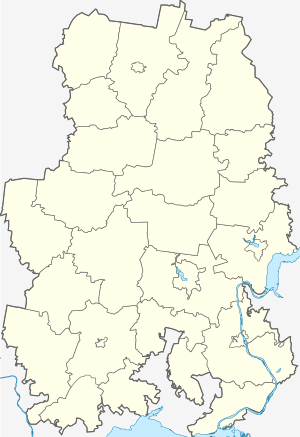Kambarka
| Kambarka (English) Камбарка (Russian) Камбарка (Udmurt) | |
|---|---|
| - Town[1] - | |
 A monument in Kambarka to the warriors fallen in the Great Patriotic War | |
.svg.png) Location of the Udmurt Republic in Russia | |
 Kambarka | |
|
| |
| Administrative status (as of October 2012) | |
| Country | Russia |
| Federal subject | Udmurt Republic[1] |
| Administrative district | Kambarsky District[1] |
| Town of district significance | Kambarka[1] |
| Administrative center of | Kambarsky District,[1] town of district significance of Kambarka[1] |
| Municipal status (as of September 2007) | |
| Municipal district | Kambarsky Municipal District[2] |
| Urban settlement | Kambarskoye Urban Settlement[2] |
| Administrative center of | Kambarsky Municipal District,[2] Kambarskoye Urban Settlement[2] |
| Statistics | |
| Population (2010 Census) | 11,021 inhabitants[3] |
| Time zone | SAMT (UTC+04:00)[4] |
| Founded | 1761–1767 |
| Town status since | 1945 |
| Kambarka on Wikimedia Commons | |
Kambarka (Russian: Камбарка) is a town and the administrative center of Kambarsky District of the Udmurt Republic, Russia, located on the Kambarka River (Kama's basin), 116 kilometers (72 mi) southeast of Izhevsk. Population: 11,021 (2010 Census);[3] 12,636 (2002 Census);[5] 13,258 (1989 Census).[6]
History
It was founded as a settlement around a Demidov ironworks, which was constructed in 1761–1767. It was granted town status in 1945.
The city of Kambarka was one of the residence centers of the Udmurt Jews.[7]
Administrative and municipal status
Within the framework of administrative divisions, Kambarka serves as the administrative center of Kambarsky District.[1] As an administrative division, it is incorporated within Kambarsky District as the town of district significance of Kambarka.[1] As a municipal division, the town of district significance of Kambarka is incorporated within Kambarsky Municipal District as Kambarskoye Urban Settlement.[2]
Economy
Kambarka Engineering Works operates in the town. Operates a chemical plant.
Chemical weapons destruction plant
A chemical weapons destruction plant was built in Kambarka during the Soviet times. This was in accordance to the obligations under the CWC to destroy all of the chemical weapon stockpiles by 2012.
International relations
Twin towns and sister cities
On May 17, 2002, Mayor Georgy Kislov signed a Sister Cities International agreement with Mayor Charlie Roberts of the city of Tooele in the United States.
References
Notes
- 1 2 3 4 5 6 7 8 Law #46-RZ
- 1 2 3 4 5 Law #81-ZR
- 1 2 Russian Federal State Statistics Service (2011). "Всероссийская перепись населения 2010 года. Том 1" [2010 All-Russian Population Census, vol. 1]. Всероссийская перепись населения 2010 года (2010 All-Russia Population Census) (in Russian). Federal State Statistics Service. Retrieved June 29, 2012.
- ↑ Правительство Российской Федерации. Федеральный закон №107-ФЗ от 3 июня 2011 г. «Об исчислении времени», в ред. Федерального закона №271-ФЗ от 03 июля 2016 г. «О внесении изменений в Федеральный закон "Об исчислении времени"». Вступил в силу по истечении шестидесяти дней после дня официального опубликования (6 августа 2011 г.). Опубликован: "Российская газета", №120, 6 июня 2011 г. (Government of the Russian Federation. Federal Law #107-FZ of June 31, 2011 On Calculating Time, as amended by the Federal Law #271-FZ of July 03, 2016 On Amending Federal Law "On Calculating Time". Effective as of after sixty days following the day of the official publication.).
- ↑ Russian Federal State Statistics Service (May 21, 2004). "Численность населения России, субъектов Российской Федерации в составе федеральных округов, районов, городских поселений, сельских населённых пунктов – районных центров и сельских населённых пунктов с населением 3 тысячи и более человек" [Population of Russia, Its Federal Districts, Federal Subjects, Districts, Urban Localities, Rural Localities—Administrative Centers, and Rural Localities with Population of Over 3,000] (XLS). Всероссийская перепись населения 2002 года [All-Russia Population Census of 2002] (in Russian). Retrieved August 9, 2014.
- ↑ Demoscope Weekly (1989). "Всесоюзная перепись населения 1989 г. Численность наличного населения союзных и автономных республик, автономных областей и округов, краёв, областей, районов, городских поселений и сёл-райцентров" [All Union Population Census of 1989: Present Population of Union and Autonomous Republics, Autonomous Oblasts and Okrugs, Krais, Oblasts, Districts, Urban Settlements, and Villages Serving as District Administrative Centers]. Всесоюзная перепись населения 1989 года [All-Union Population Census of 1989] (in Russian). Институт демографии Национального исследовательского университета: Высшая школа экономики [Institute of Demography at the National Research University: Higher School of Economics]. Retrieved August 9, 2014.
- ↑ Altyntsev A.V., "The Concept of Love in Ashkenazim of Udmurtia and Tatarstan", Nauka Udmurtii. 2013. № 4 (66), p. 131. (Алтынцев А.В., "Чувство любви в понимании евреев-ашкенази Удмуртии и Татарстана". Наука Удмуртии. 2013. №4. С. 131: Комментарии.) (Russian)
Sources
- Государственный Совет Удмуртской Республики. Закон №46-РЗ от 19 октября 2006 г. «Об административно-территориальном устройстве Удмуртской Республики», в ред. Закона №60-РЗ от 12 октября 2012 г. «О внесении изменений в отдельные Законы Удмуртской Республики». Вступил в силу через десять дней после официального опубликования. Опубликован: "Известия Удмуртской Республики", №185, 12 декабря 2006 г. (State Council of the Udmurt Republic. Law #46-RZ of October 19, 2006 On the Administrative-Territorial Structure of the Udmurt Republic, as amended by the Law #60-RZ of October 12, 2012 On Amending Various Laws of the Udmurt Republic. Effective as of the day which is ten days after the official publication.).
- Государственный Совет Удмуртской Республики. Закон №81-РЗ от 8 декабря 2004 г. «Об установлении границ муниципальных образований и наделении соответствующим статусом муниципальных образований на территории Камбарского района Удмуртской Республики», в ред. Закона №45-РЗ от 10 сентября 2007 г. «О внесении изменений в отдельные Законы Удмуртской Республики». Вступил в силу с 1 января 2005 г.. Опубликован: "Собрание законодательства Удмуртской Республики", №5, 25 июля 2005 г. (State Council of the Udmurt Republic. Law #81-RZ of December 8, 2004 On Establishing the Borders of the Municipal Formations and Granting the Status to the Municipal Formations on the Territory of Kambarsky District of the Udmurt Republic, as amended by the Law #45-RZ of September 10, 2007 On Amending Various Laws of the Udmurt Republic. Effective as of January 1, 2005.).